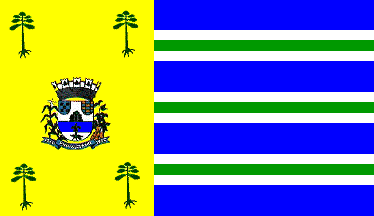 image by Dirk Schönberger,
4 January 2013 and Ivan Sache, 5 January 2013
image by Dirk Schönberger,
4 January 2013 and Ivan Sache, 5 January 2013 Based on: http://pt.wikipedia.org/wiki/Pinhalzinho_(S%E3o_Paulo)

Last modified: 2013-01-21 by ian macdonald
Keywords: sao paulo | pinhalzinho |
Links: FOTW homepage |
search |
disclaimer and copyright |
write us |
mirrors
 image by Dirk Schönberger,
4 January 2013 and Ivan Sache, 5 January 2013
image by Dirk Schönberger,
4 January 2013 and Ivan Sache, 5 January 2013
Based on:
http://pt.wikipedia.org/wiki/Pinhalzinho_(S%E3o_Paulo)
Vertically divided 2:3, yellow and blue with three horizontal white-green-white stripes, with the municipal arms in the centre of the yellow field, and a green tree in each corner of the yellow field.
Official website at
http://www.pinhalzinho.sp.gov.br/web
Dirk Schönberger,
4 January 2013
Pinhalzinho, named for the araucaria ("pinheiro") forests that once covered the region, was founded in 1840 by João Domingues Siqueira and Generoso de Godoi Bueno. Most early settlers were Italian immigrants, including Antônio Fornari and his sons, who established the first shop. Made of hardly 20 scattered huts in 1900, the village increased from 1910 onwards, when Eduardo Fornari and Henrique Torricelli built a school; at the same time, the local newspaper "Cidade de Bragança" announced that pieces of land were available for free. The district of Pinhal was established by Law no. 2,784 of 23 December 1936, as part of the municipality of Bragança (today, Bragança Paulista), and renamed Pinhalzinho by State Decree-Law No. 9,775 of 30 November 1938. The municipality of Pinalzinho was established by State Law No. 8,092 of 28 November 1964 and inaugurated on 28 March 1965.
The flag of Pinhalzinho is blue with three groups of three white-green-white horizontal stripes. A yellow rectangle is placed along the hoist, charged with the municipal coat of arms and cantoned with four green, uprooted araucarias.
Photo of the flag:
http://liveweb.archive.org/http://www.eev.com.br/orlandofornari/?area=album&pg=Pinhalzinho+Hoje
http://www.eev.com.br/orlandofornari/imagens/imgFotos134865.jpg
The coat of arms of Pinhalzinho is "Argent an araucaria vert eradicated overall a fess azure charged with a fleur-de-lis of the first in chief two escutcheons chequy argent and azure (dexter) and or/ gules and azure (sinister)."
The flag and the coat of arms are canting, recalling that the place was named for araucarias ("pinheiros"). The fleur-de-lis must recall the town's patron saint, Our Lady of Copacabana.
Ivan Sache, 5 January 2013